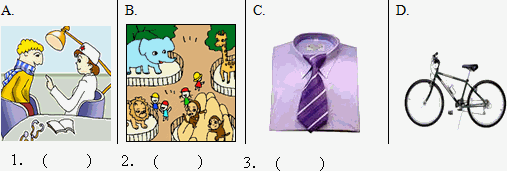
题目列表(包括答案和解析)
听力理解
一、听对话,选择与对话内容相符的图片,将代表图片的字母填写在相应序号后的括号内。每段对话读两遍。(共6分,每小题1分)
请看第一组的四幅图片,听三段对话,回答第1~3小题。

请看第二组的四幅图片,听三段对话,回答第4~6小题。

二、听对话或独白,根据对话或独白内容,从下列各题所给的选项中,选择正确答案。对话或独白朗读两遍。(共12分,每小题1.5分)
听第一段对话,回答第7~8小题。
7.Where are the two speakers?
A.In a classroom.
B.In a bank.
C.In a shop.
8.What does the woman want to do?
A.To change a sweater.
B.To borrow a sweater.
C.To wash a sweater.
听第二段对话,回答第9~11小题。
9.How does the man go to Chicago?
A.By air.
B.By train.
C.By sea.
10.Which meal does the man want to have?
A.Breakfast.
B.Lunch.
C.Supper.
11.How soon will the man be at home?
A.In two hours.
B.In three hours.
C.In four hours.
听一段独白,回答第12~14小题。
12.What’s the new problem in the country?
A.“Left-behind”children seldom get care from the government.
B.“Left-behind”children seldom get together with their parents.
C.“Left-behind”children cannot get any love from their parents.
13.Who probably look after the children whose parents have moved to work in cities?
A.Their teachers.
B.Their neighbours.
C.Their grandparents.
14.What does Wen Jiabao require local(当地的)governments to do?
A.To do more for“left-behind”children and their parents.
B.To let the schools in cities receive“left-behind”children.
C.To make the local people stop going to work in cities.
三、听下面的一段独白,根据题目要求在相应题号后的横线上记录关键信息。独白读三遍。(共8分,每小题2分)(注:生词manners礼貌,礼节)

湖北省互联网违法和不良信息举报平台 | 网上有害信息举报专区 | 电信诈骗举报专区 | 涉历史虚无主义有害信息举报专区 | 涉企侵权举报专区
违法和不良信息举报电话:027-86699610 举报邮箱:58377363@163.com